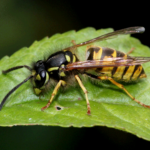In Praise of Wasps
In Praise of Wasps
Common Wasp
Along with the slug, snail and earthworm, the wasp is pretty low in ‘likes’ on the social media platform and with society at large. There are about 9,000 species of wasps here in the UK. These include the parasitic wasp (no sting) and roughly 250 larger wasps, the majority of which are solitary (do not have a social organisation). The Common Wasp, Vespula vulgaris,is the one that appears in late Summer as an uninvited and persistent guest at our picnics
This is a social wasp, and like the bumblebee, only the young fertilised Queen will hibernate during the Winter. She emerges in early Spring to build a little, walnut-sized nest, where she lays around 20 eggs. She feeds these larvae until they emerge as adult worker wasps and it is then that the nest is enlarged. The nest alone is a beautiful, engineered creation of chewed wood pulp, sometimes 40 cm in diameter. The wasp larvae are fed insects such as aphids, white fly etc.. by the adult worker. By the end of the Summer the Queen stops laying eggs and the larvae develop into adults, with no larvae to provide them the sugar solution, the adult wasps are starving. This is why they become desperate for sugary food or drinks
Apart from killing other insects to feed their larvae, wasps also pollinate, if only by accident. Since the adults mostly live on sugar, they will also visit flowers to collect nectar, moving pollen around on the way. They are also a food source for other wildlife. They are amazing, clever and vital insects. Another source of food for the starving wasp in late Summer is the ivy flower. Let’s be kinder to the Common Wasp. Don’t let them end up in wasp traps!
Harriet English
